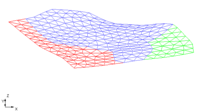GMS:2D Mesh Settings
New nodes in a 2D mesh are created by selecting the Create Nodes tool from the 2D Mesh Tool Palette and clicking where the new node is to be located. The default parameters governing the creation of new nodes can be specified using the 2D Mesh Settings command in the Mesh menu. This brings up the 2D Mesh tab of the Preferences dialog. The options in the dialog are as follows:
Contents
Default Z
If the check box entitled Interpolate for default z on interior is selected when a new node is inserted in the interior of the mesh, the element enclosing the node is linearly interpolated to get the Z value. If the node is on the exterior of the mesh, the default z value is used. If the toggle is not selected, the default Z is used everywhere.
The options in the center of the dialog are used to specify whether to use a default Z value for all new nodes or to have GMS prompt for the Z value every time a new node is created.
Assign Default Z-Value
Select to assign default Z value each time a new node is created. If Interpolate for default z on interior is selected, the program will interpolate from the already existing values to find the value of new nodes on the interior of the mesh. New nodes on the exterior of the mesh will be assigned the value in the Default z section.
Prompt for Z-Value
Select for GMS to confirm node value each time a new node is manually created. Each time a new node is manually created, a New Node dialog will appear with default Z value for the location selected. If the selection is inside the mesh and Interpolate for default z on interior is selected, the New Node dialog will populate with the interpolated Z value. If the node is outside the mesh or Interpolate for default z on interior is not selected, then the New Node dialog will populate with the value in the Default z section.
Insert Nodes into Triangulated Mesh
If the check box entitled Insert nodes into triangulated mesh is selected, any new node that lies in a region of the mesh consisting of triangular elements will automatically be incorporated into the mesh. New nodes will not be automatically incorporated into quadrilateral meshes.
Check for Coincident Nodes
If the check box entitled Check for coincident nodes is selected, any new node created using the Create Nodes tool will be checked to see if it lies on top of an existing node.
Retriangulate Voids when Deleting
When selected, GMS retriangulates the elements of a 2D mesh when a node is deleted. When it's off, deleting a node deletes all triangles that connect to that node.
Thin Triangle Aspect Ratio
Sets the minimum aspect ratio for determining thin triangles in the mesh. Triangles with an aspect ratio below the entered value can be selected using the Select Thin Triangles command or highlighted in the 2D Mesh display options.
Min Interior Angle for Merging Triangles
Defines the minimum interior angle used by GMS to decide which triangles to merge when the Merge Triangles command is used. Each of the angles in the quadrilateral elements created by the Merge Triangles command will be larger than this defined minimum. Values must be between 0° and 90°.
| GMS – Groundwater Modeling System | ||
|---|---|---|
| Modules: | 2D Grid • 2D Mesh • 2D Scatter Point • 3D Grid • 3D Mesh • 3D Scatter Point • Boreholes • GIS • Map • Solid • TINs • UGrids | |
| Models: | FEFLOW • FEMWATER • HydroGeoSphere • MODAEM • MODFLOW • MODPATH • mod-PATH3DU • MT3DMS • MT3D-USGS • PEST • PHT3D • RT3D • SEAM3D • SEAWAT • SEEP2D • T-PROGS • ZONEBUDGET | |
| Aquaveo | ||

